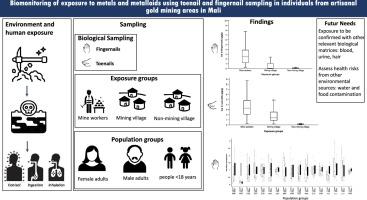Biomonitoring of exposure to metals and metalloids using toenail and fingernail sampling in individuals from artisanal gold mining areas in Mali
Q2 Environmental Science
引用次数: 0
Abstract
Artisanal gold mining can release metallic elements in the environment that can result in occupational and environmental exposures. This pilot study aimed to assess exposure to metals and metalloids from fingernail and toenail samples in artisanal gold mine workers, inhabitants of a mining and non-mining village in Mali. As it can be particularly challenging to collect and transport biological samples from remote areas, nail sample collection was tested as a potential choice for multielement biomonitoring. A convenience sampling of 315 individuals was performed equally distributed in each location group (105 per location) and stratified by populational group (male adults, female adults, and people <18 years). Toenail and fingernail samples were collected from each participant and twenty-one elements (aluminum (Al), arsenic (As), barium (Ba), beryllium (Be), cadmium (Cd), chromium (Cr), cobalt (Co), copper (Cu), gallium (Ga), iron (Fe), lithium (Li), lead (Pb), manganese (Mn), nickel (Ni), selenium (Se), silver (Ag), strontium (Sr), thallium (Th), uranium (u), vanadium (v) and zinc (Zn)) were quantified. Concentrations of 12 elements in fingernails and/or toenails were significantly higher in the mine worker group, in particular As, Co and Cu in both toenails and fingernails. In the mine worker group specifically, As concentrations in both fingernails and toenails were higher in males. Most metals also had a strong positive correlation overall. Both fingernails and toenails appear as interesting biomonitoring matrices for multielement exposure assessment with an impact of different variables, such as mining exposure and sex, on internal levels. The study also highlighted the importance of further human exposure assessment related to artisanal gold mining in Mali, including the identification of other environmental sources of exposure.

利用脚趾甲和指甲采样对马里手工采金区个体接触金属和类金属的情况进行生物监测
手工金矿开采会在环境中释放金属元素,从而导致职业和环境暴露。这项试点研究旨在评估马里一个采矿和非采矿村庄的手工金矿工人从指甲和脚趾甲样本中暴露于金属和类金属的情况。由于从偏远地区采集和运输生物样本极具挑战性,因此测试了指甲样本采集作为多元素生物监测的潜在选择。对 315 人进行了方便取样,每个地点组平均分配(每个地点 105 人),并按人口组(成年男性、成年女性和 18 岁以上人群)进行分层。收集了每位参与者的脚趾甲和手指甲样本,以及 21 种元素(铝 (Al)、砷 (As)、钡 (Ba)、铍 (Be)、镉 (Cd)、铬 (Cr)、钴 (Co)、铜 (Cu)镓(Ga)、铁(Fe)、锂(Li)、铅(Pb)、锰(Mn)、镍(Ni)、硒(Se)、银(Ag)、锶(Sr)、铊(Th)、铀(u)、钒(v)和锌(Zn))。在矿工群体中,指甲和/或脚趾甲中 12 种元素的浓度明显较高,尤其是脚趾甲和指甲中的砷、钴和铜。特别是在矿工组中,男性指甲和脚趾甲中的砷浓度更高。大多数金属总体上也有很强的正相关性。指甲和脚趾甲似乎都是用于多元素暴露评估的有趣生物监测矩阵,不同变量(如采矿暴露和性别)对内部水平都有影响。该研究还强调了进一步评估与马里手工金矿开采有关的人体暴露的重要性,包括确定其他环境暴露源。
本文章由计算机程序翻译,如有差异,请以英文原文为准。
求助全文
约1分钟内获得全文
求助全文
来源期刊

Environmental Advances
Environmental Science-Environmental Science (miscellaneous)
CiteScore
7.30
自引率
0.00%
发文量
165
审稿时长
12 weeks
期刊介绍:
 求助内容:
求助内容: 应助结果提醒方式:
应助结果提醒方式:


